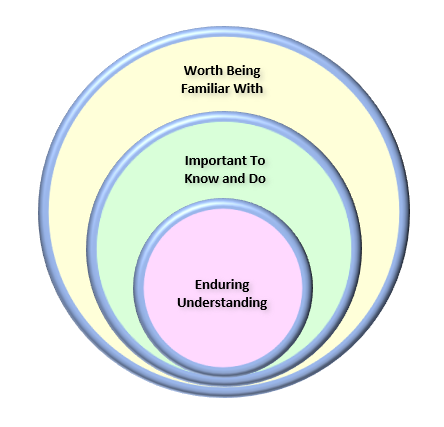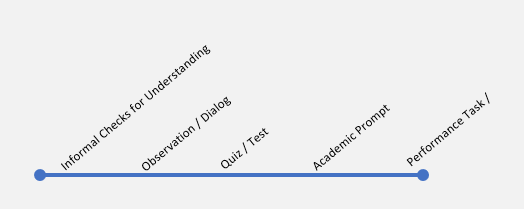Stage One - Identify Desired Results
In this first stage, we consider our goals, examine established content standards (national, state, and district), and review curriculum expectations. Given that there typically is more content than can reasonably be addressed, we are obliged to make choices.

Figure 3 shows a useful framework for establishing curricular priorities using the three nested rings model. The three nested rings represents information the learner should be familiar with, information important to know, and the information needed for enduring understanding.(1)
Outer Ring
The outer ring represents the entire universe of potential information the learner should be familiar with. This includes all possible certifications and licensing requirements for a given vocational program. Given that there is typically more content than can reasonably be addressed, the instructional designer is obliged to make choices.
The course cannot address all areas; so the largest ring identifies knowledge that students should find worth being familiar with. During the unit or course, what do we want students to hear, read, view, research, or otherwise encounter? In this first ring, the instructional designer must consider course goals, examine established content standards (national, state, and district), and review the curriculum expectations.
Middle Ring
The empty background within the middle ring represents information important to know; the field of possible content (topics, skills, and resources) that might be examined during the unit or course. In the middle ring, the instructional designer sharpens their choices by specifying important knowledge (facts, concepts, and principles) and skills (processes, strategies, and methods). This ring establishes which topics would cause the learning to be incomplete, if the learning concluded without mastery of these topics. Here is another way to think about the middle ring: It specifies the prerequisite knowledge and skills needed by students for them to successfully accomplish key performances.
Smallest Ring
The smallest ring represents information needed for enduring understanding; finer-grain choices selecting understandings that will anchor the learning. The term "enduring" refers to the big ideas, the important understandings, that the instructional designer wants students to "get inside of" and retain after they've forgotten many of the details.
The backwards design model offers four criteria, or filters, to use in selecting ideas and processes to teach for understanding.
- To what extent does the idea, topic, or process represent a "big idea" having enduring value beyond the classroom?
- To what extent does the idea, topic, or process reside at the heart of the discipline?
- To what extent does the idea, topic, or process require uncoverage?
- To what extent does the idea, topic, or process offer potential for engaging students?
Stage Two - Determine Acceptable Evidence
The backward design approach encourages instructional designers to think about a unit or course in terms of the collected assessment evidence needed to document and validate that the desired learning has been achieved. The course is not just content to be covered or a series of learning activities. The instructional designers and instructors need to consider during design and planning how they will determine if students have attained desired understandings. The evidence of understanding can cover a wide range of assessment methods.

Figure 4 shows the continuum of assessment methods ranging from checks of understanding such as oral questions; traditional quizzes, tests, and open-ended prompts; to performance tasks and projects. This assessment evidence may be gathered during the course as well as at the end.(1)
These assessments are not mutually exclusive. They can be used together over the duration of the course to provide evidence that students are able to use their knowledge in proper context.
Quiz and Test Items
Simple Content-focused Questions:
- Assess factual information, concepts, and discrete skill
- Uses selected-response or short-answer formats
- Typically have a single, best answer
- May be easily scored with an answer key
Academic Prompts
Open-ended questions or problems that requires students to think critically, not recall knowledge, and then prepare a response.
- Requires constructed responses under school or exam conditions
- No single best answer or strategy for answering or solving them
- Ill-structured, requiring the development of a strategy
- Involve analysis, synthesis, or evaluation
- Typycally requires rubric-based scoring techniques
Performance Tasks and Projects
Complex authentic challenges that model real-world tasks the students will be expected to perform.
- Features settings that simulate real environments that model the constraints, background noise, incentives, and opportunities in their future workplace
- Typically requires students to address an identified audience
- Are based on a specific purpose that relates to the audience
- Allow students the opportunity to personalize their tasks
Stage Three - Plan Learning Experiences and Instruction
Once the instructional designers have clearly identified the expected results and evidence of understanding, they can design instuctional activities. At this point, the instructional designers need to consider these key questions:
- What enabling knowledge (facts, concepts, and principles) and skills (procedures) will students need to achieve desired results?
- What activities will equip students with necessary knowledge and skills?
- What will need to be taught, and how should it best be taught, in consideration of performance goals?
- What materials and resources are best suited to accomplish these goals?
- Is the overall instructional design coherent and effective?
The actual design of instruction - including teaching methods, sequence of lessons, and resource materials - occurs after identffying desired results and assessments.
Summary and Key Design Questions
The backwards design process is uniquely suited for designing vocational training programs where the end goal is already established. Many career fields for trades require some type of formal certification awarded by either government, industry organization, or unions. For these trades, the end point is determined by agencies outside control of the instructional designer and the instructors. The instructional designer does not need to perform the same type of task analysis that the commonly used ADDIE model requires.
Table 1 provides a summary of the backwards design process in vocational training development.(1)
| Key Design Question | Design Considerations | Filters (Design Criteria) | What the Final Design Accomplishes |
|---|---|---|---|
| Stage 1. What is worthy and requiring of understanding? | National Standards. State Standards. Industry Trade Standards. | Enduring ideas. Authentic discipline-based work. Engaging. | Unit framed around enduring understandings and essential questions. |
| Stage 2. What is evidence of understanding? | Continuum of Assessment Types | Valid. Reliable. Authentic work. Student friendly. | Unit anchored in credible and educationally vital evidence of the desired understandings. |
| Stage 3. What learning experiences and teaching promote understanding, interest, and excellence? | Research-based Repertoire of Learning and Teaching Strategies. Essential and Enabling Knowledge and Skill | Where is it going? Explore and equip. Rethink and revise. Exhibit and evaluate. | Coherent learning experiences and teaching that will develop the desired understandings, promote interest, and make excellent performance more likely. |
< The Model | Contact Page >